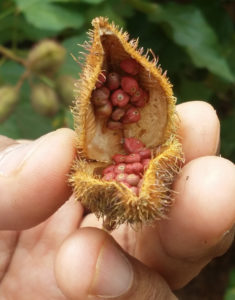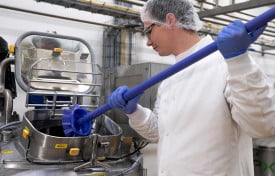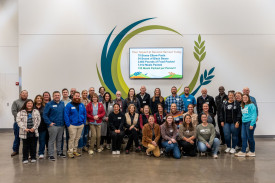Learning Center

Significantly minimize food vulnerabilities with Nelson-Jameson's food defense product solutions! According to the FDA, food defense is defined as, "the effort to protect food from acts of intentional adulteration" (Food Defense, 2020, para. 1). Intentional adulteration could include various contaminations that are intended to cause harm to the public. In order to prevent and protect from harmful contamination, a food defense plan needs to be established. A food defense plan first consists of your facility completing a vulnerability assessment. This assessment is to determine where in the facility's processes pose the greatest risk for contamination. Second, mitigation strategies need to be selected for identified vulnerabilities, and lastly, corrective action needs to be implemented. Nelson-Jameson has products that are designed to assist with mitigation and preventative strategies within your facility and aid in your food defense plan:
• Use color-coded personnel identification
Biofilms are hearty amalgams of microbiological activity that provide protection for microorganisms, and can form on a variety of surfaces in food processing environments, including stainless steel. A supercell of harborage, "Biofilms are complex microbial ecosystems formed by one or more species immersed in an extracellular matrix of different compositions depending on the type of food manufacturing environment and the colonizing species" (Geaile, et al). The "matrix" formed creates a powerful source of protection and fuel.
Though biofilms are capable of creating a lot of hassle when it comes to cleaning, spoilage concerns, etc., Gaile, et al, in "Biofilms in the Food Industry: Health Aspects and Control Methods" note: "Of particular importance to the food industry is that some biofilm-forming species in food factory environments are human pathogens." With biofilms aiding and abetting pathogens, the cost of not waging an effective sanitation onslaught, may create food safety
September is Food Safety Education Month! According to the FDA, the importance of food safety is learning and educating others on taking an active role in preventing foodborne
Whether you make beverages, confectionery, dairy products, ice cream, or other prepared foods, together with Oterra, we can help match the exact color you need for your product. Covering natural colors, fruit, and vegetable concentrates, there are more than 600 unique products. Together we will work to develop unique new colors designed to optimize your formulation and bring extra value to your new, or redesigned products.
Oterra has a robust global quality management system and supply chain that promise to consistently deliver the right quality, at the right time, and in the right amount. Focusing on quality control, product safety, and product security at every stage of activity throughout the entire value chain—raw material selection, surveillance of suppliers through production and packaging, distribution, and application on your premises.
Forty years ago, DSM introduced Delvotest®, an easy to use, reliable, antibiotic residue test for farmers, dairies, and milk control laboratories. Today, Delvotest® is the gold standard for antibiotic residue testing in the global dairy industry, since it provides the confidence to meet increasingly stringent global legislation and quality demands.
When it comes to individuals daily food consumption, the last thing we seem to worry about is the presence of antibiotic residue in our meats or dairy products. But if a dairy cow had an antibiotic in its system that was designed to fight off a bacterial infection, the residue from the antibiotic could easily be carried over to the milk the cow produced, which is not good. If the entire tank truck of milk was contaminated with antibiotics, the whole thing must be discarded per the FDA.
Have you heard the term Annatto before? You're probably wondering if it's a fun tropical island you can travel to, or maybe even an article of clothing you can wear, but really, it's something that is more prevalent in your daily life than you had imagined.
Annatto is a type of food coloring made from the seeds of the achiote tree. It ranges from yellow to red-orange in hue, depending on the application and dosage rate, and is a staple in the food and beverage industry. It is also considered a staple in the dairy industry because it is stable, economical, and comes in a wide variety of forms, including powder, paste, liquid, and essential oils, making it applicable for use in
To craft cheeses with precise flavors and textures tailored to specific markets, cheesemakers must carefully select cultures, adjuncts, and coagulants. The choice of coagulant is particularly crucial for cheeses like pasta filata, cheddar, and continental varieties, where texture, sliceability, and shredability significantly impact productivity and profitability. Selecting a coagulant enzyme with low proteolytic activity, specifically targeting k-casein, enhances texture, moisture distribution, and sliceability, leading to reduced waste during slicing. Coagulants also play a pivotal role in flavor development by supporting cheese ripening and preventing the hydrolysis of β-caseins, avoiding bitter off-flavors. dsm-firmenich Ingredients, through products like Delvo®Cheese starter cultures and Delvo®ADD adjuncts, provides cheesemakers with the tools to optimize texture and taste, meeting the demands of diverse markets. Maxiren® and Fromase® from dsm-firmenich cater to
A critical component in food safety is the detection of contaminants. One of the worst nightmares of anyone working in food processing, is finding something in the final product that is not supposed to be there. This can cause costly product loss, clean-up and maintenance costs, and the potential for recalls and/or litigation. Even though everyone tries to prevent foreign object contamination, pieces of tools such as scrapers can break off, or items such as pens can fall into the product. To make sure that these items are caught, and that contaminated product does not make it out the door, many plants utilize metal detection devices and products.
Metal detectable products are constructed of a few different materials. They are often blue for easy visual detection. Blue is also the most common non-food color.
The COVID-19 pandemic disrupted normal operations for countless food and beverage manufacturers. Disruptions from future pandemics may occur due to limited staff because of layoffs, social distancing requirements, or sickness; additional sanitation requirements to control viral transmission; changes in production levels; and possibly plant shutdown. These situations can lead to the need of resources for food safety sanitation.
It is essential that food manufacturers create safe, quality food, therefore, routine practices need to continue and additional sanitation may need to be added. Employers also need to ensure a safe environment for their staff, including minimizing the risk of being exposed to harmful viruses and infections.
Selecting the right safety sign is a critical task in maintaining a secure work environment, and several key factors must be considered in this process. OSHA and ANSI regulations mandate that signage effectively communicates and defines specific hazards that pose a risk of injury or even death if left unidentified. One crucial aspect to contemplate is the safety sign header, which specifies the degree of hazard applicable to your situation. Different headers cater to distinct hazard levels, ensuring a clear and accurate indication of potential dangers. Explore the nuances of Danger, Warning, Caution, Notice, and Safety First signs, each serving a unique purpose in conveying the severity of potential hazards. Whether it's an immediate danger with a high probability of severe consequences or a cautionary note about a potentially hazardous situation, understanding the distinctions in safety signage headers is essential for creating a safe and informed workplace.








